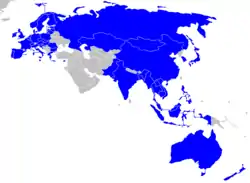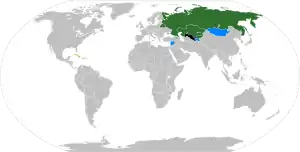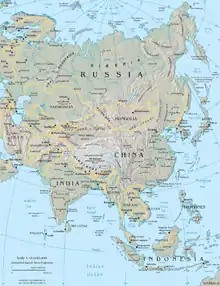Eurasia
Eurasia (/jʊəˈreɪʒə/, also UK: /-ʃə/) is the largest continental area on Earth, comprising all of Europe and Asia.[3][4] Primarily in the Northern and Eastern Hemispheres, it spans from the British Isles and the Iberian Peninsula in the west to the Japanese archipelago and the Russian Far East to the east. The continental landmass is bordered by the Atlantic Ocean and Africa to the west, the Pacific Ocean to the east, the Arctic Ocean to the north, and by Africa, the Mediterranean Sea, and the Indian Ocean to the south.[5] The division between Europe and Asia as two continents is a historical social construct, as many of their borders are over land; thus, in some parts of the world, Eurasia is recognized as the largest of the six, five, or four continents on Earth.[4] In geology, Eurasia is often considered as a single rigid megablock. However, the rigidity of Eurasia is debated based on paleomagnetic data.[6][7]
.svg.png.webp) | |
| Area | 55,000,000 km2 (21,000,000 sq mi) |
|---|---|
| Population | 5,360,351,985 (As of 16 October 2019)[1][2] |
| Population density | 93/km2 (240/sq mi) |
| Demonym | Eurasian |
| Countries | ~93 countries |
| Dependencies | 9 dependencies |
| Time zones | UTC−1 to UTC+12 |
Eurasia covers around 55 million square kilometres (21 million square miles), or around 36.2% of the Earth's total land area. It is also home to the largest country in the world, Russia. The landmass contains well over 5 billion people, equating to approximately 70% of the human population. Humans first settled in Eurasia between 60,000 and 125,000 years ago. Some major islands, including Great Britain, Iceland, Ireland, and Sri Lanka, and parts of Japan, the Philippines, and most of Indonesia, are often included in the popular definition of Eurasia, despite being separate from the contiguous landmass.
According to some geographers physiographically, Eurasia is a single continent.[4] The concepts of Europe and Asia as distinct continents date back to antiquity, and their borders are geologically arbitrary and have historically been subjected to occasional change. Eurasia is connected to Africa at the Suez Canal, and Eurasia is sometimes combined with Africa to make the largest contiguous landmass on Earth, called Afro-Eurasia.[8] Due to the vast landmass and differences in latitude, Eurasia exhibits all types of climates under the Köppen classification, including the harshest types of hot and cold temperatures, high and low precipitation, and various types of ecosystems.
Geology

Eurasia formed between 375 and 325 million years ago with the merging of Siberia, Kazakhstania, and Baltica, which was joined to Laurentia (now North America), to form Euramerica. Chinese cratons collided with Siberia's southern coast.
History
Eurasia has been the host of many ancient civilizations, including those based in Mesopotamia, the Indus Valley and China. In the Axial Age (mid-first millennium BC), a continuous belt of civilizations stretched through the Eurasian subtropical zone from the Atlantic to the Pacific. This belt became the mainstream of world history for two millennia.
Geopolitics
Originally, "Eurasia" is a geographical notion: in this sense, it is simply the biggest continent; the combined landmass of Europe and Asia. However, geopolitically, the word has several meanings, reflecting specific geopolitical interests.[9] "Eurasia" is one of the most important geopolitical concepts and it figures prominently in the commentaries on the ideas of Halford Mackinder. As Zbigniew Brzezinski observed on Eurasia:
"... how America 'manages' Eurasia is critical. A power that dominates 'Eurasia' would control two of the world’s three most advanced and economically productive regions. A mere glance at the map also suggests that control over 'Eurasia' would almost automatically entail Africa's subordination, rendering the Western Hemisphere and Oceania geopolitically peripheral to the world’s central continent. About 75 per cent of the world's people live in 'Eurasia', and most of the world's physical wealth is there as well, both in its enterprises and underneath its soil. 'Eurasia' accounts for about three-fourths of the world's known energy resources."[10]
— Zbigniew Brzezinski, The grand chessboard : American primacy and its geostrategic imperatives
The Russian "Eurasianism" corresponded initially more or less to the land area of Imperial Russia in 1914, including parts of Eastern Europe.[11] One of Russia's main geopolitical interests lies in ever closer integration with those countries that it considers part of "Eurasia."[12] This concept is further integrated with communist eschatology by author Alexander Dugin as the guiding principle of "self-sufficiency of a large space" during expansion.[13]
The term Eurasia gained geopolitical reputation as one of the three superstates in 1984,[14] George Orwell's[15] novel where constant surveillance and propaganda are strategic elements (introduced as reflexive antagonists) of the heterogeneous dispositif such metapolitical constructs used to control and exercise power.[16]

Regional organisations and alliances
Across Eurasia, several single markets have emerged, including the Eurasian Economic Space, European Single Market, ASEAN Economic Community, and the Gulf Cooperation Council. There are also several international organizations and initiatives which seek to promote integration throughout Eurasia, including:

Asia-Europe Meeting
- Every two years since 1996 a meeting of most Asian and European countries is organised as the Asia–Europe Meeting (ASEM).
Commonwealth of Independent States
- The Commonwealth of Independent States (CIS) is a political and economic association of 10 post-Soviet republics in Eurasia formed following the dissolution of the Soviet Union. It has an estimated population of 239,796,010. The CIS encourages cooperation in economic, political, and military affairs and has certain powers to coordinate trade, finance, lawmaking and security. In addition, six members of the CIS have joined the Collective Security Treaty Organization, an intergovernmental military alliance that was founded in 1992.

Eurasian Union
- Similar in concept to the European Union, the Eurasian Union is an economic union established in 2015 including Russia, Armenia, Belarus, Kazakhstan, Kyrgyzstan and observer members Moldova, Uzbekistan, and Cuba. It is headquartered in Moscow, Russia and Minsk, Belarus. The union promotes economic integration among members and is theoretically open to enlargement to include any country in Europe or Asia.
Federation of Euro-Asian Stock Exchanges
- The Federation of Euro-Asian Stock Exchanges (FEAS) is an international organization headquartered in Yerevan, comprising the main stock exchanges in Eastern Europe, the Middle East and Central Asia. The purpose of the Federation is to contribute to the cooperation, development, support and promotion of capital markets in the Eurasian region.

Russia-EU Common Spaces
- The Russia - EU Four Common Spaces Initiative, is a joint European Union and Russian agreement to closer integrate Russia and the EU, remove barriers to trade and investment and promote reforms and competitiveness. In 2010, Russian Prime Minister Vladimir Putin called for common economic space, free-trade area or more advanced economic integration, stretching from Lisbon to Vladivostok. However, no significant progress was made and the project was put on hold after Russia-EU relations deteriorated following the Russo-Ukrainian War in 2014.
Shanghai Cooperation Organisation
- The Shanghai Cooperation Organisation is a Eurasian political, economic and security alliance, the creation of which was announced on 15 June 2001 in Shanghai, China. It is the largest regional organisation in the world in terms of geographical coverage and population, covering three-fifths of the Eurasian continent and nearly half of the human population.
Use of term
History of the Europe–Asia division

In ancient times, the Greeks classified Europe (derived from the mythological Phoenician princess Europa) and Asia which to the Greeks originally included Africa [17] (derived from Asia, a woman in Greek mythology) as separate "lands". Where to draw the dividing line between the two regions is still a matter of discussion. Especially whether the Kuma-Manych Depression or the Caucasus Mountains form the southeast boundary is disputed, since Mount Elbrus would be part of Europe in the latter case, making it (and not Mont Blanc) Europe's highest mountain. Most accepted is probably the boundary as defined by Philip Johan von Strahlenberg in the 18th century. He defined the dividing line along the Aegean Sea, Dardanelles, Sea of Marmara, Bosporus, Black Sea, Kuma–Manych Depression, Caspian Sea, Ural River, and the Ural Mountains. However, at least part of this definition has been subject to criticism by many modern analytical geographers like Halford Mackinder, who saw little validity in the Ural Mountains as a boundary between continents.[18]
Geography
In modern usage, the term "Eurasian" is a demonym usually meaning "of or relating to Eurasia" or "a native or inhabitant of Eurasia".[19] It is also used to describe people of combined "Asian" and "European" descent.
Located primarily in the eastern and northern hemispheres, Eurasia is considered a supercontinent, part of the supercontinent of Afro-Eurasia or simply a continent in its own right.[20] In plate tectonics, the Eurasian Plate includes Europe and most of Asia but not the Indian subcontinent, the Arabian Peninsula or the area of the Russian Far East east of the Chersky Range.
From the point of view of history and culture, Eurasia can be loosely subdivided into Western and Eastern Eurasia.[21]
Soviet states after decentralization

Nineteenth-century Russian philosopher Nikolai Danilevsky defined Eurasia as an entity separate from Europe and Asia, bounded by the Himalayas, the Caucasus, the Alps, the Arctic, the Pacific, the Atlantic, the Mediterranean, the Black Sea and the Caspian Sea, a definition that has been influential in Russia and other parts of the former Soviet Union.[22] Nowadays, partly inspired by this usage, the term Eurasia is sometimes used to refer to the post-Soviet space – in particular Russia, the Central Asian republics, and the Transcaucasus republics – and sometimes also adjacent regions such as Turkey and Mongolia.
The word "Eurasia" is often used in Kazakhstan to describe its location. Numerous Kazakh institutions have the term in their names, like the L. N. Gumilev Eurasian National University (Kazakh: Л. Н. Гумилёв атындағы Еуразия Ұлттық университеті; Russian: Евразийский Национальный университет имени Л. Н. Гумилёва)[23] (Lev Gumilev's Eurasianism ideas having been popularized in Kazakhstan by Olzhas Suleimenov), the Eurasian Media Forum,[24] the Eurasian Cultural Foundation (Russian: Евразийский фонд культуры), the Eurasian Development Bank (Russian: Евразийский банк развития),[25] and the Eurasian Bank.[26] In 2007 Kazakhstan's president, Nursultan Nazarbayev, proposed building a "Eurasia Canal" to connect the Caspian Sea and the Black Sea via Russia's Kuma-Manych Depression to provide Kazakhstan and other Caspian-basin countries with a more efficient path to the ocean than the existing Volga-Don Canal.[27]
This usage can also be seen in the names of Eurasianet,[28] The Journal of Eurasian Studies,[29] and the Association for Slavic, East European, and Eurasian Studies,[30] as well as the titles of numerous academic programmes at US universities.[31][32][33][34][35]
This usage is comparable to how Americans use "Western Hemisphere" to describe concepts and organizations dealing with the Americas (e.g., Council on Hemispheric Affairs, Western Hemisphere Institute for Security Cooperation).
See also
- Asia-Europe Foundation
- Asia–Europe Meeting
- Afro-Eurasia
- Borders of the continents
- Council of Europe
- Community for Democracy and Rights of Nations
- Eastern European Group
- Eastern Partnership
- Eurasia (Nineteen Eighty-Four)
- Eurasian (disambiguation)
- Eurasian Economic Community
- Eurasia Tunnel
- Eurasia Canal
- Eurasian Union
- Eurasianism
- European Union
- Euronest Parliamentary Assembly
- Federation of Euro-Asian Stock Exchanges
- Intermediate Region
- Laurasia, a geological supercontinent joining Eurasia and North America.
- List of Eurasian countries by population
- Marmaray, railway tunnel links Europe to Asia.
- Neo-Eurasianism
- Organization of the Black Sea Economic Cooperation
- Organization for Security and Co-operation in Europe
- Palearctic
- Shanghai Cooperation Organisation
- United States of Eurasia
- Vega expedition, the first voyage to circumnavigate Eurasia
References
- "Population of Europe (2019) - Worldometers". www.worldometers.info. Archived from the original on 11 September 2019. Retrieved 15 July 2019.
- "Population of Asia (2019) - Worldometers". www.worldometers.info. Archived from the original on 21 July 2019. Retrieved 16 October 2019.
- Nield, Ted. "Continental Divide". Geological Society. Archived from the original on 3 December 2013. Retrieved 8 August 2012.
- McDaniel, Melissa; Sprout, Erin; et al. (20 September 2011). "How many continents are there?". Continent. National Geographic Society. Archived from the original on 16 July 2019. Retrieved 27 July 2017.
By convention there are seven continents: Asia, Africa, North America, South America, Europe, Australia, and Antarctica. Some geographers list only six continents, combining Europe and Asia into Eurasia. In parts of the world, students learn that there are just five continents: Eurasia, Australia (Oceania), Africa, Antarctica, and the Americas.
- "What is Eurasia?". geography.about.com. Archived from the original on 18 November 2012. Retrieved 17 December 2012.
- Pavlov, V. E. (9 October 2012). "Siberian paleomagnetic data and the problem of rigidity of the Northern Eurasian continent in the post-Paleozoic". Izvestiya, Physics of the Solid Earth. 48 (9–10): 721–737. Bibcode:2012IzPSE..48..721P. doi:10.1134/S1069351312080022. S2CID 129745964. Retrieved 12 October 2022 – via SpringerLink.
- Li, Yong-Xiang; Shu, Liangshu; et al. (13 July 2013). "Magnetic inclination shallowing problem and the issue of Eurasia's rigidity: insights following a palaeomagnetic study of upper Cretaceous basalts and redbeds from SE China". Geophysical Journal International. 194 (3): 1374–1389. Bibcode:2013GeoJI.194.1374L. doi:10.1093/gji/ggt181. ISSN 0956-540X. Retrieved 12 October 2022.
- McColl, R. W., ed. (2005). 'continents' – Encyclopedia of World Geography, Volume 1. Golson Books Ltd. p. 215. ISBN 9780816072293. Archived from the original on 9 June 2016. Retrieved 26 June 2012.
And since Africa and Asia are connected at the Suez Peninsula, Europe, Africa, and Asia are sometimes combined as Afro-Eurasia or Eurafrasia.
- Andreen, Finn (15 April 2014). "The Concept of Eurasia". Blogger.com /. Comment and Outlook. Archived from the original on 6 June 2014. Retrieved 6 June 2014.
- Brzezinski, Zbigniew (1997). The grand chessboard : American primacy and its geostrategic imperatives ([Repr.] ed.). New York, NY: Basic Books. p. 31. ISBN 978-0465027262.
- Nartov, N. A. (2004). Geopolitika : [učebnik] (3rd ed.). Moskva: Edinstvo. Part 2.4, p. 50. ISBN 978-5238006826.
- Andreen, Finn. "The Concept of Eurasia". Blogger.com. Commentary and Outlook. Archived from the original on 30 January 2016. Retrieved 6 June 2014.
- Dugin, Alexander (21 March 2017). "Eurasia: A Special Worldview". The Fourth Political Theory. Archived from the original on 31 May 2017. Retrieved 30 April 2017.
- Tovy, Tal (2015). The changing nature of geostrategy, 1900-2000: the evolution of a new paradigm (PDF). Maxwell Air Force Base, Alabama: Air University Press. Air Force Research Institute. p. 19. ISBN 978-1-58566-253-1. Archived (PDF) from the original on 7 August 2019. Retrieved 8 March 2019.
- Porter, Patrick (27 February 2012). "The Maps are Too Small: Geography, Strategy and the National Interest". Foreign & Commonwealth Office. Government Digital Service. Archived from the original on 27 July 2019. Retrieved 8 March 2019.
- Ingram, Alan (2017). "Art, Geopolitics and Metapolitics at Tate Galleries London" (PDF). Geopolitics. 22 (3): 719–739. doi:10.1080/14650045.2016.1263186. S2CID 151769284. Archived (PDF) from the original on 12 April 2019. Retrieved 3 March 2019.
- Wiesner-Hanks, Merry E. (2006). Early Modern Europe, 1450-1789. Cambridge University Press. p. 2. ISBN 9780521005210.
- Davies, Norman (1996). Europe: A History. p. 8. ISBN 978-0-19-820171-7. Retrieved 23 August 2010.
- American Heritage Dictionary
- "Pangaea Supercontinent". Geology.com. Archived from the original on 13 January 2011. Retrieved 19 February 2011.
- Sengupta, Anita (2009). Heartlands of Eurasia: The Geopolitics of Political Space. Lexington Books. p. 25.
Anthropologically, historically and linguistically Eurasia is more appropriately, though vaguely subdivided into West Eurasia (often including North Africa) and East Eurasia
- Schmidt, Matthew (2005). "Is Putin Pursuing a Policy of Eurasianism?". Demokratizatsiya. 1 (13): 90.
- "L. N. Gumilyov Eurasian National University". Emu.kz. 29 July 2010. Archived from the original on 28 February 2009. Retrieved 7 August 2010.
- "The Eurasian Media Forum". Eamedia.org. Archived from the original on 9 April 2010. Retrieved 7 August 2010.
- "Eurasian Development Bank". Eabr.org. Archived from the original on 24 May 2010. Retrieved 7 August 2010.
- "Eurasian Bank". Eurasian-bank.kz. Archived from the original on 24 November 2010. Retrieved 7 August 2010.
- Canal will link Caspian Sea to world Archived 11 September 2011 at the Wayback Machine (The Times, 29 June 2007)
- "Eurasianet". Archived from the original on 1 October 2019. Retrieved 13 March 2017.
- Journal of Eurasian Studies. Elsevier. Archived from the original on 13 March 2017. Retrieved 13 March 2017.
- "About ASEEES". Association for Slavic, East European, and Eurasian Studies. Archived from the original on 23 March 2017. Retrieved 13 March 2017.
- "Slavic and Eurasian Studies". Duke Graduate School. Archived from the original on 13 March 2017. Retrieved 13 March 2017.
- "Russian and Eurasian Studies". George Mason University. Archived from the original on 18 January 2017. Retrieved 13 March 2017.
- "Department of Slavic and Eurasian Studies". University of Texas at Austin. Archived from the original on 13 March 2017. Retrieved 13 March 2017.
- "Center for Russian, East European and Eurasian Studies". Stanford University. Archived from the original on 13 March 2017. Retrieved 13 March 2017.
- "Institute of Slavic, East European and Eurasian Studies". University of California, Berkeley. Archived from the original on 14 February 2017. Retrieved 13 March 2017.
Further reading
- The Dawn of Eurasia: On the Trail of the New World Order by Bruno Maçães, Publisher: Allen Lane
- D. Lane, V. Samokhvalov, The Eurasian Project and Europe Regional Discontinuities and Geopolitics, Palgrave: Basingstoke (2015)
- V. Samokhvalov, The new Eurasia: post-Soviet space between Russia, Europe and China, European Politics and Society, Volume 17, 2016 – Issue sup1: The Eurasian Project in Global Perspective (Journal homepage)
- Lewis, Martin W.; Wigen, Kären E. (1997). The Myth of Continents: a Critique of Metageography. Berkeley: University of California Press. ISBN 978-0-520-20743-1.
External links
 Media related to Eurasia at Wikimedia Commons
Media related to Eurasia at Wikimedia Commons
.svg.png.webp)
.svg.png.webp)
.svg.png.webp)
.svg.png.webp)


.svg.png.webp)
_political.svg.png.webp)
.svg.png.webp)
.svg.png.webp)